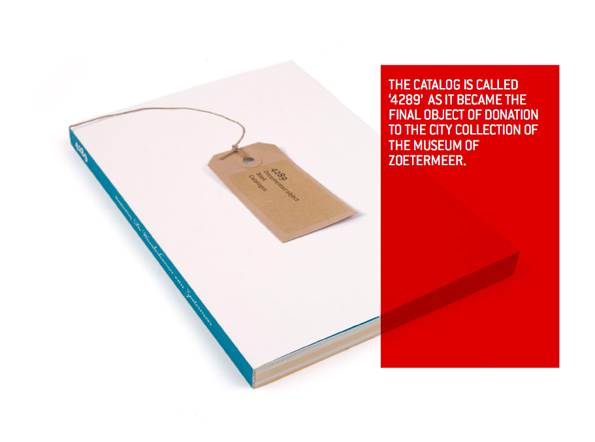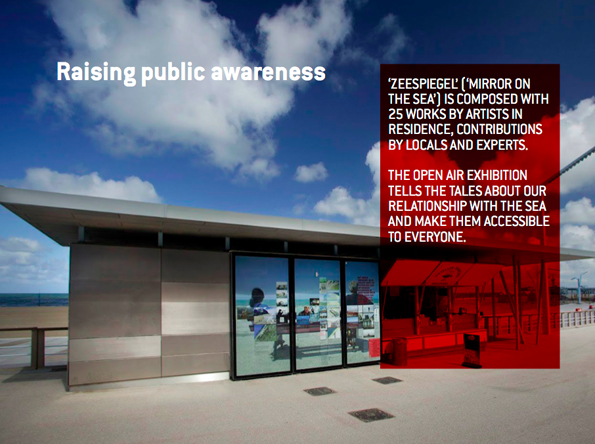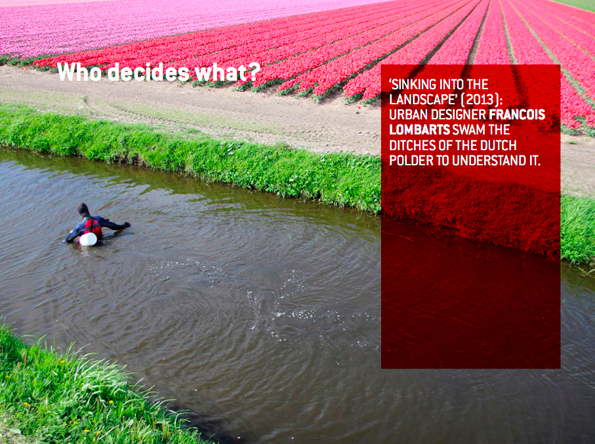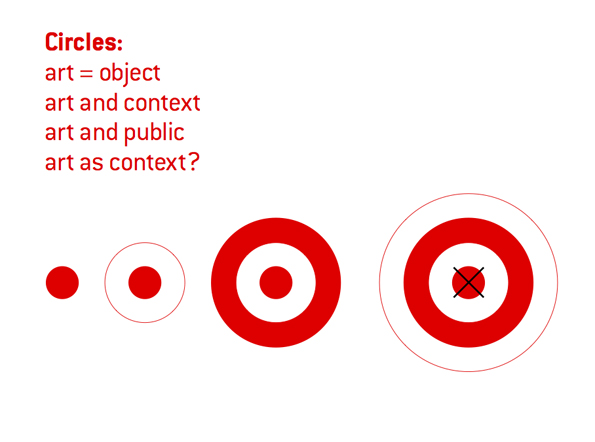Guestspeaker at ICOMRio2013
| 2013-07-22 11:25:39
ICOMRio2013 @ Rio de Janeiro, Brazil August 10-17 2013, Cidade das Artes
View online presentation below
Curator/founding director of Satellietgroep Jacqueline Heerema gave a presentation at the international museology conference ICOMRIO2013 August 10 - 17.
During this annual conference of ICOM (the International Council of Museum) the International Committee for Collecting COMCOL will discuss comtemporary thinking on collection developments. The focus will be on 'The (Re)interpretation and (Re)usages of (Older) Collections and their Value for Contemporary Society'.
Heerema talks during the conference/COMCOL Session II: 'generating new meaning for collections' about the role of participating communities in designing 'innovatory' hertitage with regards to the Dutch coastal area and elsewhere.
http://www.icomrio2013.org.br/
Conference theme: Museums (memory + creativity) = social change
Museums wish and work to promote change. The mathematical equation inspiring the 23rd General Conference of the International Council of Museums suggests that this work arises from a composition between creative freshness and the memory constructed and entrusted to these museums. Behind this equation there are numerous individuals strengthened each day: professionals and especially the public, full of aspirations, acting as engines of this movement. It is the memory activated by creativity in the museum environment reverberating in the society and promoting social change.
The International Council of Museums (ICOM), created in 1946, is the only organisation of museums and museum professionals with a global scope, committed to the promotion and protection of natural and cultural heritage, present and future, tangible and intangible. With approximately 30,000 members in 137 countries, ICOM is a unique network of museum professionals acting in a wide range of museum-and heritage-related disciplines.
COMCOL is ICOM International Committee with the mission to deepen discussions and share knowledge on the practice, theory and ethics of collecting and collections (both tangible and intangible) development. COMCOL is a platform for professional exchange of views and experiences around collecting in the broadest sense. The Committee is in charge of collecting and de-accessioning policies, contemporary collecting, restitution of cultural property and respectful practices. COMCOL’s aims are to increase cooperation and collaboration across international boundaries, to foster innovation in museums and to encourage and support museum professionals in their work with collections development. COMCOL organizes annual meetings and working groups and publishes a newsletter for its members.
http://network.icom.museum/comcol

The Niterói Contemporary Art Museum (Museu de Arte Contemporânea de Niterói — MAC) is situated in the city of Niterói, Rio de Janeiro, Brazil. Designed by Oscar Niemeyer, completed in 1996.
PRESENTATION:
CAN ART CONTRIBUTE TO NEW CONCEPTS OF HERITAGE, MUSEUMS, COLLECTING AND SOCIETY?
ICOMRio2013
Conference theme: Museums (memory + creativity) = social change
COMCOL Session II: 'Generating new meaning for collections'
Curator/founding director of Satellietgroep Jacqueline Heerema (NL) is invited to give a presentation at the international museology conference ICOMRio2013 in Rio de Janeiro Brazil, August 10 - 17. During this annual conference of ICOM (the International Council of Museums) the International Committee for Collecting COMCOL will discuss contemporary thinking on collection developments. Heerema talks during the conference/COMCOL Session II: 'generating new meaning for collections' about the role of participating communities in designing 'innovatory' heritage with regards to the Dutch coastal area and elsewhere.

What do you value most?

Thank you for being invited. Thanks specially to Leontine Meijer van Mensch, who had the courage to invite me - as an artist - to talk at this expert event.
My first reaction to the conference theme ‘Museums (memory + creativity) = social change’ was to turn it around into the question: ‘is it by creative societies that the museum environment is challenged to enhance social change by (re)defining memories?’
Can art contribute to new concepts of heritage, museums, collections and society?

‘Break Down’ (2001): Michael Landy destroyed as a ritual artwork all his 7000 personal belongings.
What do you value most?
When you visit people at home, even if home is a simple shack in a refugee camp, you find people surround themselves with the things they value most. When I ask you what you value most, you may mention your family, or that picture of your mother?
Understanding collecting is basically understanding your own values, as a person, as a member of a family, a community and society and as an expert.

My name is Jacqueline Heerema, I’m from The Netherlands, Europe. I am a trained conceptual artist, studied museology, work as independent urban curator, started my own ‘museum’, deconstructed the classic concept of museums in ‘The Chamber of Marvels’, and since 2006 initiate and collect works on anthropogenic coastal transitions. Most of all I collect, connect and interconnect local knowledge on global level. My favorite role is to be the catalyst between local communities, arts and science.
I use my artistic conceptual freedom to question our presumptions and manipulations that we accept, integrate and create in our daily lives. Who is in the position that determines and decides on the what and why? What is important, what should be cherished and kept for future generations, become part of our global heritage and may contribute to understanding the incomprehensible?
I would like to share 3 projects with you in the next 15 minutes:
1. Museum Oostwijk
2. The Chamber of Marvels
3. Anthropogenic collection on coastal transitions

1.
Museum Oostwijk
Perceptions of cultural identity
2002-2009

In 2002 I was invited to investigate the perceptions of cultural identity of the residents in Oostwijk, the eastern part of a small Dutch town. An urban area consisting of 10.000 inhabitants of all social economic levels and with multiple origins. The town mayor and the Turkish guest worker who sweeps the streets live in this small community. A rather quiet and friendly urban area with no big issues, a place where you might consider living yourself because people live nicely among each other. Interesting, because somehow this multi layered community figured out a way to handle social differences? So, how do they do it? What lessons are there to be learned?

300 Cookie Jars were introduced at the opening of the museum as a symbol, a homely metaphor for the sense of feeling at home, of connecting.
Starting form the concept that everybody is a director and curator of a museum I converted this urban neighboorhood into ‘Museum Oostwijk’. I shifted the established construction of formal museums 180 degrees and stated that everybody and everything in this area is part of the collection of the Museum. All persons, young or old, their dreams, hopes, memories and expectations became part of the collection. All houses, pets, crafts and knowledge became part of the collection. The inhabitants became the directors, curators and guides of the Museum. I invited artists and experts to work along with the inhabitants on research to disclose this collection. They worked alongside, the inhabitants as inexperienced experts together with ‘official’ professionals, trying to figure out the secret of their success of living harmoniously together including all social and ethnic differences.
(example the audio tour where visitors could walk through the neighboorhood and listen to the stories behind the walls).

Scooter kids. Research on informal communication and locality, common interests and local practices.
After 7 years we documented the whole project in a catalog that was spread house to house in all 3500 households, thus transferring the immaterial collection back to the community. The material collection was formally transferred to the city archive.
30% of all 10.000 inhabitants participated in one or more projects of the Museum. Recently the Oostwijk became an urban conservation area.

Catalog Museum Oostwijk. Research into The Cookie Jar showed that 47,5 % use the cookie jar for cookies, 37,5 % use the cookie jar for small items and 15% use the cookie jar for collecting. Some kids kept the content secret, as it contained very personal stuff.
2.
CHAMBER OF MARVELS
De Wonderkamer van Zoetermeer / The Chamber of Marvels of Zoetermeer
Deconstructing the concept of museums.
2008-2009

Being invited to talk at museology conferences and in training or educational meetings, resulted in the invitation of the City Museum of Zoetermeer to help them out with a community collecting project called ‘Give & Take’. Zoetermeer is a New Town and more or less exploded since the sixties from a village of 9000 inhabitants to 120.793 inhabitants in 2008. The tiny City Museum of Zoetermeer invited the locals to donate an object and a story about ‘their sense of home’ to the Museum. The interesting thing was, that all donations became part of the City Collection. 88 donations were contributed. People came to the museum with their personal donation in a plastic shopping bag, and the object and story was transferred and accepted by the curator after putting on the white protection gloves.
I decided to publicly deconstruct the system of museums and museology. Every step in the process of an object and story being transferred into a museum object as part of a collection was researched within the museum spaces, together with the locals and experts. I invited all donators, artists, writers, philosophers and museology experts to share the process in 4 steps:
The Naked Object, the Talking Object, Object Speeddating and Beyond the Object.
The Naked Object = observation
The Talking Object = perception
Object Speeddating = composition and cohesion
Beyond the Object = transformation

In the first phase we focused on observation, what do you see when you look at an isolated object? In the second phase we focused on perception: how does a story add to the meaning of the object? In the third phase we focused on composition and cohesion, what do all these objects and stories mean together? And the final phase centered around transformation, has the public research of this community collection added meaning and understanding to the locals, the museum, the town?

Omslag 4289 / Catalog 4289
Thanks to the museology experts involved, the project resulted in the catalog called ‘4289’ as it became the final object of donation to the City Collection of the Museum of Zoetermeer. 1200 copies were spread to the donators and all museums, heritage and training institutions in The Netherlands. I described and documented the artistic context of the whole project in the edge of the catalog and online.
3.
Satellietgroep
Anthropogenic collection on coastal transitions
Collecting the intangible?
Since 2006
I like to share with you some thoughts that came from these projects and in exchange with some of your colleagues present at this conference.

Since 2006 Satellietgroep explores through arts and culture how the sea and waterways influence people, communities and environments.
Let me first introduce the third project on coastal transitions.
In 2006 I co-founded Satellietgroep, an artist run initiative that explores through arts and culture how the sea and waterways influence cities, people, communities and environment.
Our aim is to enhance public and professional awareness on coastal transitions.

‘Asstrooiveld’ (2012:) Eric van Straaten / Sea field for scattering the ashes of deceased persons
The Netherlands below sea level.
Coastal transitions have an impact on
- social/community/culture
- conceptual/philosophic
- ecology/environment
- politics/economics/tourism

Oceans, seas and coastal regions are under tremendous pressure, worldwide.
What trigerd this initiative was the lack of involvement of arts and culture in the master plans for coastal transitions in The Netherlands. As you may know, The Netherlands is a country mostly below sea level with expert skills of water management and with a world famous artistic tradition. With the prospect of climate change, rising sea level, shrinking land, dis-balance of salt and sweet water, rivers too full or empty, we face major coastal transitions. Transitions in spatial and economical sense that may lead to conflicts, estrangements, loss of heritage and loss of more informal cultural uses of public coastal space.

Exchange of local knowledge on globel level – Badgast – Now Wakes The Sea.
Our long term projects are 'Badgast' - artist in residency program at the coast of The Hague/ Scheveningen and 'Now Wakes The Sea', the international exchange residency program in collaboration with international cultural partners in coastal communities abroad.
In these projects new works and concepts are developed that reflect on the geographical, ecological, conceptual and philosophical shifts due to coastal transitions. We invite international artists and scientists to jointly develop and present research articulating a cultural, innovative and sustainable significance of the sea and its coasts by doing on-site research, engage with local communities, collaborate with local experts and connect to international networks. With these works they contribute to the international contemporary collection on coastal transitions of Satellietgroep to be shared with broader audiences, on public and professional venues.
Through exchange projects in The Netherlands and abroad, Satellietgroep interconnects coastal communities by contextualizing contemporary research and new works to historic and future coastal developments and works.

Raising public awareness.
'Zeespiegel' ('Mirror on the Sea')
One of the results of the program is the free and permanent open air photo exhibition 'Zeespiegel - Mirror on the Sea' on the new boulevard of The Hague at Scheveningen. Composed by Satellietgroep with artworks of 25 artists in residence of Badgast, locals en professionals the exhibition tells the tales about our relationship with the sea and make them accessible to everyone.

Raising professional awareness.
Keynote speaker at Littoral 2012.Sharing these results at professional venues may contribute to raising awareness on the cultural aspects of coastal transitions. At the international coastal conference Littoral2012 in Belgium we gave a talk to 200 international coastal experts from 22 countries.
Anthropogenic coastal atlas
In close collaboration with international artists, scientists, curators and guest curators Satellietgroep now develops the Anthropogenic coastal atlas. This cultural atlas will become an onlineplatform for public and professional use for geographical, typological and narrative explorations into the complex and layered coastal transitions, to be connected to ICAN’s network of scientific coastal atlasses.
After 7 years we are now invited to work with the Dutch government, scientists and engineers to link cultural perception and experience with scientific knowledge and vision.

Anthropogenic coastal atlas, interconnecting coastal communities.
Innovatory heritage?
Lately I posed that heritage has a new connotation and not the type of heritage that is something only to be smartly managed and maintained (like the English definition of ‘Innovative heritage’) or state in human/culture versus nature but one that can be seen as an active cyclic system of understanding, like Newton stated that action = - reaction. Heritage is alive and kicking!
Museologist Peter van Mensch recently stated at the finissage of our project ‘Stellingname’ that arts can (also) contribute to new concepts about heritage, by developing new questions that derive heritage from dogmatic and institutionalized notions (Peter referred to the internal discourses about accreditation, registration and preservation in museums) to new ideas about how material heritage shifts to immaterial heritage, in the sense that is shifts from tangible as the carrier of intangible heritage?
Is the concept of ‘innovatory’ heritage aimed at getting free from the authority discourse, the dogmas?
One of the interesting questions is, how to dissolve dogmatic thinking and acting …in the sense that heritage is a dynamic concept, and deals with past, present and future? Heritage no longer deals with the representation of the past as ‘innovatory’ heritage focuses on the future!

‘Sinking into the landscape’ (2013): urban designer Francois Lombarts swam through the ditches of the Dutch polder to understand it.
So, the main question is 'Who decides what?'
I like to state that arts, culture and heritage belong to everybody. Not to a selections of experts. Not within walls. There are (or should be) no physical barriers for intellectual or conceptual exchange on different levels. Being aware of, even deconstruct the systems of our appreciations or values of heritage, culture and arts is essential by critical observations, understanding perceptions, interpretations and manipulations.
If we reflect on this talk and my professional expierences these last decades, does it essentially deal with the shifts of the concept of arts and proposes a new role in redefining culture and heritage?
art = object
art and context
art and public
art as context?

I describe these shifts mostly as circles. This first inner circle is ‘art as object’, and refers to the tangible qualities of artworks. Artworks as objects, that have a defined material shape, like a statue or a painting.
A work of art can be described by title, artist, date, size, materials etc. In such, it could refer to 'autonomous art' (which I doubt exists) in which the intentional meaning of the artist is ‘sacred’.
‘Art and context’ is the second circle around the first, and refers to artworks that do no only longer consist of a defined shape in space. This can reach as far as that the object as material shape itself is dissolved in an environmental work of art, and is even made for that purpose.
The third circle encompassing the other 2, I call this ‘art and audience’ and it refers not only to conceptual arts, but also to the sense that the object as material shape is non-existent and the senses of the audience are evoked by intangible experiences.
(I never use the word ‘community art’ as it deals with non-artistic goals within the range of care and welfare.)
Now the fourth circle or cloud may be ‘art as context’! In my opinion, it refers to the concept of arts that no longer deals with the objects themselves but with a ‘collective of intangible’. In this construct we accept that arts is subject to timely reflections and interpretations, in as much that the ‘intentional meaning’ of the artists/makers are no longer exclusive but inclusive, and subject to changes, interpretations, manipulations, etc. Is it about the construction of arts, culture and heritage? And, who decides what?
There is never one story to tell. Culture is in essence questioning the why and how we negotiate between experiencing and understanding the world that surrounds us. How do we position ourselves in the context of family and heritage, roots and wish full thoughts, even shape our future aims? Everyday we pose these questions, when we raise our children, what believes and rituals do we install in educating the young? What stories do we tell, and how do we manipulate these stories, about our origins and presumed identity? How do we connect to these issues in contact with the people that matter to us? What make-belief worlds do we instill in the young, the future generations that will follow us?

‘Drawing Horizon' (2010): artist James Geurts (AU) built a site-specific solar powered light installation on the Dutch beach facing the North Sea.
Conclusion
Lately I call myself narrative curator. I'm mostly interested in the conceptual and contextual nature of contemporary arts. Not as a discourse within the domain of arts, but as a dialogue interconnecting different fields of reflections on arts, culture, heritage and science… in short the things we tend to value important. There is never one story to tell. The former top down approach shifts to a broader understanding, more inclusive and based on social, artistic or scientific research in the how, why en when we construct the incomprehensible world around us.

We started with this picture. So what does this image tell us?
The woman on the left is the grandmother who shared this picture with me. She grew up on the seaside and this picture celebrates the event that for the first time she is playing with sand on the beach with her grandson. The picture is taken by her daughter, the mother of the boy.
The context of the event tells the story of The Netherlands as a country below sea level: the sand they sit on is put on the beach for coastal protection, on the right you see the boulevard which is actually a dike in boulevard for coastal protection, and in the background you see the derelict bankrupt pier, as a relic of former touristic progress and nostalgia and contemporary competing coastal destinies; the Dutch national flag completes the picture.
Thank you for your attention.
I hope you enjoyed it as I enjoyed composing this talk for this expert audience.
Culture is dynamic, it is the world we all create together. Culture is a construction of interpretations of histories, peoples, tales and beliefs. Culture is the way of expressing how we stand in life, in society and in the way we negotiate with issues that matter to us. History and memory are adaptable to the timeframe we live in. In that sense heritage and culture - as a manifestation of what was, is and will be - is a timely interpretation, may even be a necessity to survive? The main question is: who manipulates what and why?
www.jacquelineheerema.nl
www.satellietgroep.nl
Links to some projects:
WIND MEE: http://www.jacquelineheerema.nl/windmee/index.html
Museum Oostwijk: http://www.jacquelineheerema.nl/catalogusMO.htm
De Wonderkamer van Zoetermeer/The Chamber of Marvels: http://www.jacquelineheerema.nl/4289.htm
www.satellietgroep.nl
Badgast: http://www.satellietgroep.nl/about_badgast/1
Artist in residence Badgast: http://www.satellietgroep.nl/badgast_air_sea/1
Cinema and Talks at Badgast: http://www.satellietgroep.nl/cinema_sea/1
International exchange Now Wakes The Sea: http://www.satellietgroep.nl/now_wakes_the_sea/1
Research The Hague Cultural Capital 2018?: http://www.satellietgroep.nl/actueel/1/who_decides_what_the_hague_candidate_cultural_capital_of_europe_2018
Public exhibition: http://www.satellietgroep.nl/fotoroute_boulevard
Professional presentation: http://www.satellietgroep.nl/actueel/1/key_note_speaker_at_littoral_2012
